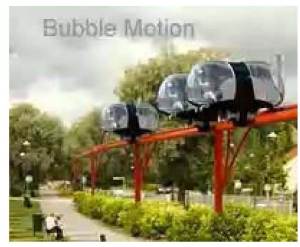Also discussed here: Evaluating Public Transit Benefits and Costs (123 page pdf, Todd Litman, Victoria Transport Policy Institute, Apr. 15, 2011)
And here: Bubble Motion PRT concept (BM Design, slideshow, April 2011)
And here: Personal Rapid Transit (PRT) network - Cutting Car Use in Daventry (Colin Buchanan)
One of my favourite sources of information about transportation modes and the maestro for the World Streets blog, Erik Britton, borrows some recent facts from another key transportation guru, Todd Litman, to present a list of factors that need to be considered in assessing transit and personal rapid transit with private vehicles.

Key Quotes:
Factors to consider in comparison:
- “Automobiles require a vehicle, road space and parking facilities at every destination
- Motor vehicles only serve the portion of travelers who can afford them and are able to drive or hire a driver
- A large portion of automobile travel consists of chauffeured trips
- Expanding urban roadways often simply shifts the location of traffic congestion
- Automobile travel is very resource intensive, requiring 10-100 times as much land area for roads and parking, and 10-1,000 times as much non-renewable energy, as the same trips made by walking, cycling and public transport
- A typical car is only operated one or two daily hours, compared with 14-18 for a typical bus. A typical car lasts 10-15 years, a typical bus or train 15-40 years”
- PRT systems require passengers to travel in enclosed “pods” with strangers, which creates insecurity problems
Related articles
- Will you commute via 'personal rapid transit?' (cnn.com)
- Oil-proof Canada’s transit systems with electricity (theglobeandmail.com)
- FiveThirtyEight: Thinktanks Gone Wild: On the Economics of Mass Transit and the Value of Common Sense (fivethirtyeight.blogs.nytimes.com)
- $1B rapid transit line suggested for Victoria (cbc.ca)
- San Francisco to LA via Public Transit: Only $45 and 30 Hours of Travel (sfist.com)
- Gas prices push commuters to the train (money.cnn.com)
- Fancy Public Transit of the Day (geeks.thedailywh.at)
- Masdar City Abandons Public Transportation System of the Future (singularityhub.com)
- Sustainable Suburbia? Eco-Friendly Masdar City Holds First Market (newsfeed.time.com)
- Inside Masdar City: a modern mirage (guardian.co.uk)
- Sound Transit funds research on rail, bus ridership (seattletimes.nwsource.com)
- Talking Transit in Vancouver - online, in the news, and in person... (vancouverpublicspace.wordpress.com)

No comments:
Post a Comment